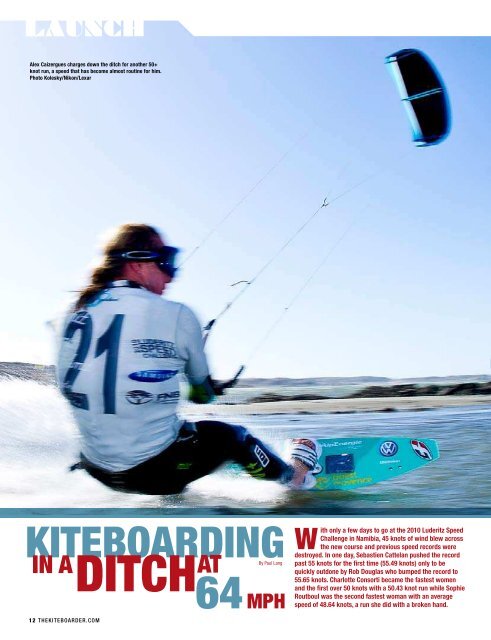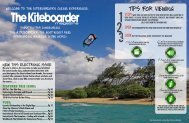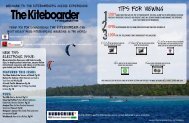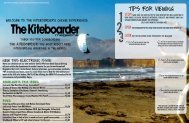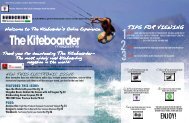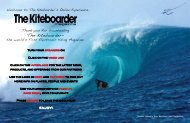Banana Hammocks - The Kiteboarder Magazine
Banana Hammocks - The Kiteboarder Magazine
Banana Hammocks - The Kiteboarder Magazine
You also want an ePaper? Increase the reach of your titles
YUMPU automatically turns print PDFs into web optimized ePapers that Google loves.
LAUNCH<br />
Alex Caizergues charges down the ditch for another 50+<br />
knot run, a speed that has become almost routine for him.<br />
Photo Kolesky/Nikon/Lexar<br />
Zach Kleppe entertains the crowd with a particularly good wipeout.<br />
<strong>The</strong>se speed records are recorded as average speeds over a 500 meter course<br />
located in a remote part of Africa that resembles a shallow ditch. For this year’s<br />
event, the course was redesigned by organizer and competitor Sebastien Cattelan.<br />
He said, “I designed the channel to begin 50 meters further upwind, which<br />
straightens the course. To avoid a wind shadow caused by a surrounding hill, we<br />
extended the channel by 250 meters at the start to ensure that from the start line<br />
the speeds were already fast. After that the channel ran at a constant 135° angle<br />
downwind, ensuring riders could be at full power when they crossed the finish line.”<br />
At 55.65 knots, Rob Douglas averaged 64 mph (103 kph) while hitting max speeds<br />
of over 58 knots (66 mph/107 kph). At that speed, he covered the entire 500 meters<br />
of the course in about 17.5 seconds. “I planned on taking the first run that day up<br />
to 53.5 knots, fast enough for a new American record and to put some pressure<br />
on the leaders, but as soon as I put the kite into the zone and held on through the<br />
first couple of gears, I knew I was onto something serious,” said Rob. While these<br />
records have yet to be ratified by the World Sailing Speed Record Council (WSSRC)<br />
at press time, it’s expected that they will be. When that happens, a kiteboarder will<br />
once again hold the world speed sailing record as the fastest wind powered craft<br />
on the water. Many people in the sailing world like to complain that these records<br />
shouldn’t count because kiteboarders aren’t real sailboats, but the plain truth is that<br />
kiteboarders with stock kites and a few custom boards are faster than the speedspecific<br />
sailboats built just for this record that have budgets stretching into the<br />
hundreds of thousands or even millions of dollars.<br />
Luderitz is a very remote town, so there’s not a lot to do there while waiting for the<br />
wind to come up enough for record attempts. Alex Caizergues said, “Luderitz is really<br />
a special place stuck between the Namib Desert, some diamonds mines, and the<br />
cold Atlantic Ocean. <strong>The</strong> town is really quiet, I mean too quiet, and sometimes the<br />
streets can be totally empty, like a ghost town, and that’s a very strange feeling!”<br />
Sebastien Cattelan had to deal with putting on an event with limited resources. He<br />
said, “<strong>The</strong> next town is 190 miles away. <strong>The</strong> only way to get to Luderitz is by car. You<br />
can’t get everything you need, but we were able to find a 24-ton excavator to build<br />
the course. An old German army truck was used by the Time Keeper and housed all<br />
of his equipment. We used four shipping containers for storage and had a rescue<br />
boat with a top speed of 45 knots. Everybody in town was very enthusiastic and<br />
welcomed us like long lost family.” For Rob, the ample time gave him a chance to<br />
question what he was doing there. “Mentally this place is a serious challenge for me.<br />
<strong>The</strong> weather forecasts give you four or five days warning before a big 45-50 knot<br />
blow. That’s plenty of time to ask yourself some serious questions. Do I need to put<br />
By recording a run of 55.65 knots, Rob Douglas is now the fastest<br />
kiteboarder (and sailor) on the planet. Photo Adrien Freville<br />
myself in this situation What if I break something bad I’ve got a wife at home, I’m<br />
not getting paid enough for this #@$@!, etc. You look for excuses to not run the<br />
place at low tide. I let my coach Mike Gebhardt make the call to go or not go and<br />
that left me with the task of just kiting. That helped take some of the pressure off<br />
and kept the stress levels low!”<br />
What makes the achievements of all the competitors at Luderitz this year even more<br />
amazing is that the new speed course was a narrow trench with dirt on either side.<br />
According to WSSRC rules, the water in the trench must be at least 18” deep, but at<br />
low tide there wasn’t enough water to compete. Sebastien decided to close the end<br />
of the channel to keep the water in, meaning that when riders crossed the finish line<br />
at over 60 mph, they had 70-150 meters (depending on who you ask) of room to<br />
stop before hitting dirt. “For some riders it was a mental challenge to have the end<br />
of the channel closed,” said Sebastien. “<strong>The</strong>y saw it as an obstacle at the end that<br />
prevented them from keeping their speed up until the finish line. In an ideal world<br />
we would have had a wider, longer channel, especially at the end, but this simply<br />
was not possible – if we left the channel open we lost the water depth. If we did not<br />
close the channel we would not have been able to reach the speeds we did.” <strong>The</strong><br />
decision to close the channel was controversial with some of the competitors, who<br />
demanded it be left open. When asked about that, Cattelan said, “What people have<br />
to remember is that this is an extreme sport and the competitors have to push their<br />
limits in order to break the existing records. That is what makes this competition so<br />
unique – we are pushing boundaries all the time and if people cannot cope with the<br />
challenge then they should not be participating in an event like this.”<br />
Every year the remote Namibian town<br />
of Luderitz becomes home to the<br />
fastest kiteboarders in the world for<br />
five weeks. Photo Kolesky/Nikon/Lexar<br />
For a video interview with Rob<br />
Douglas as well as video of his<br />
record run and his crash, go to<br />
www.thekiteboarder.com/2010/11/<br />
video-interview-with-rob-douglas/<br />
Even the top competitors seem to be intimidated by this course. Rob said, “This course<br />
was very fast and somewhat dangerous, but that comes with the territory. Imagine<br />
stepping out of a jeep as it screams across the beach at 65+ mph. Now hook into to<br />
your favorite 9 meter — hairy and gnarly for sure!” Alex Caizergues, who finished third<br />
at the event with a run of 54.93 knots, said, “<strong>The</strong> exit was crazy, with only 70 meters<br />
after the finish line to decelerate from more than 100 kph to zero! <strong>The</strong> only way to stop<br />
before hitting the shore (full of rocks) and then the hill was to crash the kite as soon as<br />
you passed the finish line and pray that you didn’t tangle your lines.”<br />
Kiteboarding<br />
By Paul Lang<br />
in a<br />
12 thekiteboarder.com<br />
at<br />
Ditch 64 MPH<br />
With only a few days to go at the 2010 Luderitz Speed<br />
Challenge in Namibia, 45 knots of wind blew across<br />
the new course and previous speed records were<br />
destroyed. In one day, Sebastien Cattelan pushed the record<br />
past 55 knots for the first time (55.49 knots) only to be<br />
quickly outdone by Rob Douglas who bumped the record to<br />
55.65 knots. Charlotte Consorti became the fastest women<br />
and the first over 50 knots with a 50.43 knot run while Sophie<br />
Routboul was the second fastest woman with an average<br />
speed of 48.64 knots, a run she did with a broken hand.<br />
After his record-setting run, Rob decided to do one more run as the immediate<br />
result isn’t always completely accurate. “I took a second run just in case as the<br />
speeds you see on the display after a run are estimated and can go up or down .2<br />
to .5 of a knot. After crossing the finish, I crashed and got my legs caught in the bar<br />
and lines. With the kite looping and dragging me feet first at 45+ knots I went over<br />
the sand and snapped my wrist as I tried to get to the release. I flew home to Boston<br />
for surgery the next day and the Doc expects a full recovery. Three days before the<br />
run I told my younger brother Jamie that I was willing to break an ankle or wrist for<br />
the new record, but nothing more, and that’s what happened.<br />
Organizer Sebastien Cattelan decided to close the channel at the end of the run, a<br />
controversial move that was designed to keep the water level in the ditch high enough to<br />
compete. Photo Adrien Freville<br />
thekiteboarder.com 13


